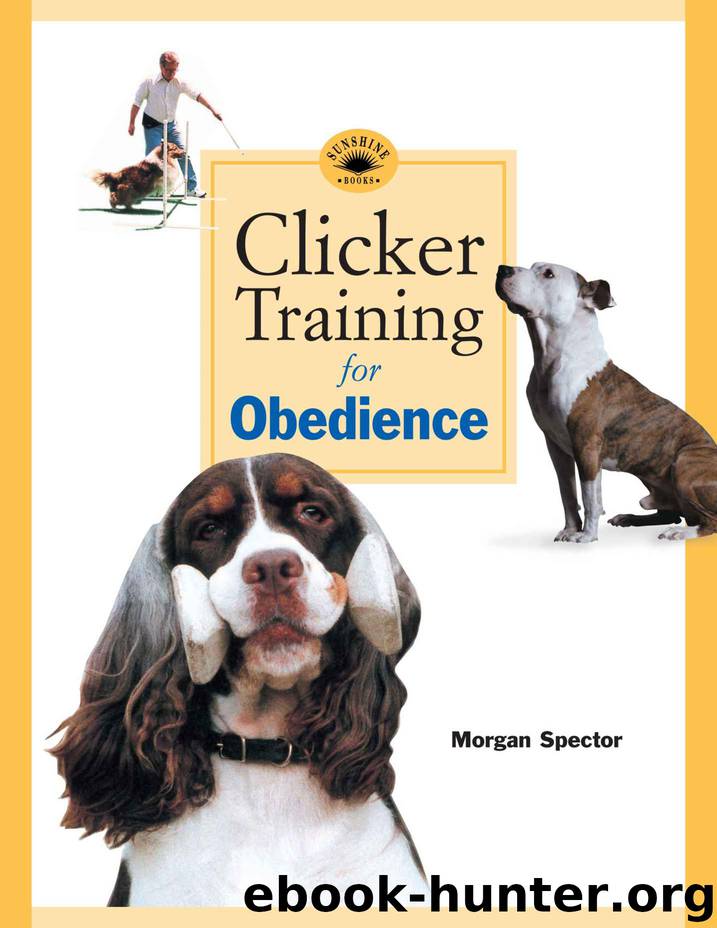Clicker Training for Obedience by Morgan Spector

Author:Morgan Spector [Spector, Morgan]
Language: eng
Format: azw3
Tags: ebook, book
Publisher: Karen Pryor Clicker Training
Published: 2014-07-09T04:00:00+00:00
The two-step halt. The dog will be more confident and more precise if your footwork is precise and consistent. This halt pattern encourages quick sits.
I have been to many seminars and heard a lot of opinion back and forth about whether you stop on your left foot or your right foot. There is about an even split of opinion, and plenty of good reasoning to go around. I train my dogs for both, simply because I want to be able to halt quickly without worrying whether my footwork is “correct.” However, I do have a preference.
I like to stop using my right foot to “brake” forward momentum, stopping on my left foot and “catching up” with my right. The simple reason is that my dogs are working off my left foot, and if I bring it all the way forward and halt, there is virtually no chance that they will be lagged. On the other hand, I sometimes find a slight lag if I stop on my right foot and catch up with my left. That’s because my body shifts ever so slightly with the first stopping step, so the dog is already starting to sit when my left foot catches up. The other reason is practical, for the competitor who shows outside: You often encounter uneven ground. By taking your last step with your right foot, your weight shifts slightly to your right when you stop; if you are on uneven ground and have any imbalance, this will take you away from the dog, thus avoiding such things as stepping on his foot or falling on top of him.
Your dog already knows how to sit and how to do so with proper posture and alignment. You have stimulus control over the sit; that is, you have added the cue (“Sit”) and the dog will sit on cue. If you have been really diligent, you have shaped a quick response to the “sit” cue by putting the behavior on limited hold. Now you can incorporate the sit into actual heeling.
Simultaneously as your body starts to straighten on your stop step, say “Barfy, sit.” As you are saying “sit,” bring your “catch-up” foot up even with your “stop” foot, bringing you to a full halt. At first, Barfy will sit slowly. This is the result of uncertainty (remember, you are adding something new). C/T the sit response even if slow. Remember too that you can only train one thing at a time. You want Barfy to learn that when you stop moving, he sits. That’s the only lesson you’re going to teach at first. You’re not even going to worry about posture, straight in line, or alignment. Your only concern is that Barfy sits when you stop moving forward.
Once Barfy sits consistently when you stop moving forward, rebuild latency so that he is sitting immediately as your brake foot hits the ground. Then, shape posture, direction, and alignment. At each stage, reintroduce latency once the new criterion is in place. In other words, make the immediate sit a constant throughout.
Download
This site does not store any files on its server. We only index and link to content provided by other sites. Please contact the content providers to delete copyright contents if any and email us, we'll remove relevant links or contents immediately.
Finding Gobi by Dion Leonard(2632)
Grumpy Cat by Grumpy Cat(2466)
A New Earth: Awakening to Your Life's Purpose by Eckhart Tolle(2371)
The Silkworm by Robert Galbraith(2345)
Tippi by Tippi Hedren(2097)
End of Days by Sylvia Browne(2050)
Total Cat Mojo by Jackson Galaxy(1919)
Backyard Chickens Beyond the Basics by Pam Freeman(1851)
The Animals Among Us by John Bradshaw(1751)
The Ultimate Pet Health Guide by Gary Richter(1681)
Vet in Harness by James Herriot(1611)
All Things Bright and Beautiful by James Herriot(1610)
Doggy Desserts: 125 Homemade Treats for Happy, Healthy Dogs by Cheryl Gianfrancesco(1588)
Cesar's Way by Cesar Millan(1584)
Dog Years by Mark Doty(1569)
Chicken Soup for the Ocean Lover's Soul by Jack Canfield(1548)
Dog Training 101 by Kyra Sundance(1504)
Walking with Peety by Eric O'Grey(1503)
Encyclopedia of Dog Breeds by D. Caroline Coile Ph.D(1390)
